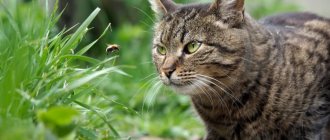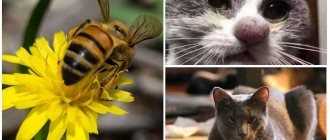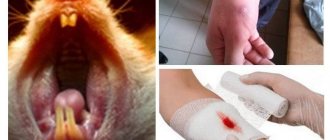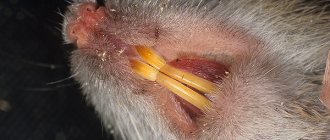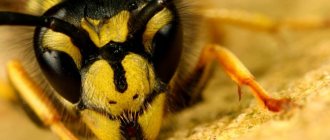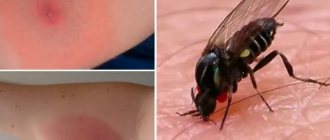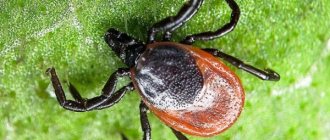In summer, dogs often become victims of stinging insects. Pets react painfully to bites. In some cases, an allergy may occur, which leads to swelling and redness of the skin, rash, and itching. The dangers are swelling of the larynx, leading to suffocation, and anaphylactic shock. These serious consequences often result in death. Therefore, if your beloved dog is bitten by a bee during a walk , urgent action must be taken .
Symptoms
How to recognize that a wasp or bee has stung your dog? This can be done based on a number of signs. The animal begins to behave restlessly. Whines and makes plaintive sounds. The area where the poison enters the skin may swell.
The behavior of a pet after an attack by a stinging insect depends on the location of the bite. The most commonly affected areas are the face, paws and ears. Symptoms vary and require separate consideration.
Paws
After a painful bite, a four-legged friend behaves as follows:
- gnawing, licking the damaged area with his tongue;
- refuses to step on the sore paw, especially if the insect has stung the pad;
- whines when walking.
A pet that has been bitten by bees may develop general weakness and stress caused by a sudden fright.
Bites to the face are extremely unpleasant for animals. Especially if a wasp or bee stings the oral mucosa. Dogs often try to catch flying insects with their mouths, not realizing that they are exposing one of the most vulnerable parts of their body.
There are a large number of blood vessels on the mucosa . The sublingual area is dangerous. There is an important nerve node there. When an insect bites this area, cramps may develop - involuntary sharp muscle contractions. Usually they are local in nature (spasms cramp the forelimbs). What to do, how to help the dog? Place the animal on its right side, ensuring silence if possible. If the attack lasts more than 5 minutes, you must call an experienced veterinarian.
The greatest likelihood of negative consequences if a bee bites a dachshund, pug, or other small breed in the face . The fact is that small animals have a relatively high heart rate. The insect's venom, along with the blood, quickly spreads throughout the body, causing intoxication of the body and allergies.
If the muzzle or mouth is injured, the dog whines, howls, and rubs the bite site with its paws. She may experience increased salivation, swelling, and difficulty breathing. Often the animal refuses food.
Ears
One of the weak points is the ears. A swelling forms at the site of the bite and hardening occurs. A clear symptom for a dog that has been bitten by a bee or wasp is a loud squeal from the animal. The pet tries to relieve the pain and itching that has arisen, scratching the ear with its paw.
If such symptoms are detected, it is necessary to carefully examine the animal. Do you have significant swelling or swelling that is making it difficult to breathe? You should immediately contact your veterinarian for emergency treatment.
How dangerous is bee venom for four-legged animals?
Due to the structure of their bodies, bees do not bite, but sting. When attacked, they dig into the skin with a stinger and immediately lose it. In addition to the sac with poison, this organ contains part of the intestine, so after its loss the insect dies.
For the person bitten, bee venom is dangerous due to the following consequences:
- Mild allergic reaction. In most cases, it is accompanied by slight swelling, redness and itching in the affected area. It goes away quickly after taking antihistamines or goes away on its own after a couple of hours.
- Quincke's edema. It often spreads to the larynx and can cause suffocation due to narrowing of the airways.
- Anaphylactic shock. It can also cause suffocation, but in this case, breathing problems appear almost instantly. In the absence of timely assistance, death from oxygen starvation occurs within a couple of hours or even minutes.
The likelihood of complications increases not only with a tendency to allergies, but also with multiple bites. For this reason, the most dangerous stinging insects include wasps that do not lose their stings.
The affected area also plays a significant role. The most sensitive areas include the eyes, nose, lips and tongue. Such attacks are especially difficult for small breed dogs and puppies - since the relative amount of injected poison for their body will always be greater. They also have a more intense heartbeat, which helps the poison spread quickly.
First aid
What should an owner do if his pet, for example a Chihuahua, is bitten by a bee or wasp? Show cold blood and put aside panic. First aid consists of the following:
- Emergency removal of insect stings . How to do? Extremely carefully using small scissors and tweezers. You can use, for example, a thin door lock key or a bank card. It should be remembered that when a wasp stings, the sting does not remain in the skin. The poison is released by insects directly into the soft tissue.
- Antiseptic treatment . gauze swab is applied to the bite site . It is moistened with an antiseptic, which can be chlorhexidine, ammonia, hydrogen peroxide, iodine, vodka or any alcohol solution .
- Applying a cold compress . It is advisable to apply a bag or a plastic bottle with ice to the sore spot. Cold will relieve swelling, relieve pain, and reduce the rate of absorption of poison.
What to do next to reduce the negative consequences of a bee or wasp sting on a dog? After providing first aid to an adult or puppy, it is necessary to treat any diseases that have appeared: allergies, inflammation, itchy skin. Each of the secondary ailments has its own treatment method.
We are looking for the culprit
It is important to understand who attacked the companion in order to properly provide first aid. Bees have serrations on their sting, so it remains inside along with the poison sac. The insect dies, and the other defenders flock to the smell of the poisonous sting.
Wasps sting more painfully and are able to bite. They have a smooth sting, so insects often attack several times. The same goes for bumblebees and hornets. The latter are more dangerous, as they often get into fruits. A dog may accidentally swallow an insect and be injured.
Pets usually receive one or more bites. Rarely is an animal attacked by a whole swarm. However, in any case, it is important to examine the companion and look for any damage. Bites in the area of the throat, nose, tongue and lips are especially dangerous: swelling of the mucous membrane can cause suffocation.
Allergy
While walking, your dog was stung by a bee or wasp, developed an allergic reaction, and you don’t know what to do? It is urgent to administer an antihistamine. This may be chloropyramine or tavegil. Diphenhydramine shows good results, but pharmacies sell it with a doctor's prescription. Medicines are administered by injection. The dose is selected depending on the size of the bitten dog (its weight).
- up to 10 kg - 0.1 ml/kg;
- from 10 to 20 kg - 1 ml;
- more than 20 kg - 2 ml.
What should you do if your dog is bitten by a wasp on the cheek or lip and severe swelling develops ? A glucocorticosteroid drug, dexamethasone, . It is an immunosuppressive, anti-inflammatory drug. Used for anaphylactic shock, edema, acute manifestations of allergies. The dosage of the medicine is selected taking into account the size of the dog according to the formulas specified in the instructions.
What to do if a puppy or an adult is bitten by a bee, and the sore spot is itchy and itchy? will help : fenistil, sinaflan . Or traditional hydrocortisone ointment (1%).
You should not self-medicate if the animal has developed an acute form of allergy: the tongue has turned blue, heavy breathing has appeared. You should immediately take your pet to a specialist.
Antiallergic drugs
In case of a bite in the face or lip, or the onset of an acute allergy, it is necessary to give injections rather than give tablets: the latter act too slowly, and the stung area swells very quickly. Therefore, dog breeders should purchase a couple of ampoules of the following drugs so that they are always on hand in their home veterinary medicine cabinet. You should also take the ampoules with you during trips to nature - to keep them safe and sound, wrap them in foil.
- You can buy suprastin or tavegil in ampoules at the pharmacy without a prescription. Diphenhydramine is also suitable - but, unlike the previous ones, it is available with a prescription.
- Dexamethasone, also in ampoules.
In case of severe swelling, some veterinarians recommend additionally injecting the dog with a diuretic (furosemide) and magnesium.
Treatment and relief of edema
Was your dog bitten by a wasp? There is a high probability of developing inflammation and swelling. Swelling may appear immediately after the poison enters the body, or over the next 2-3 hours. To eliminate the condition, medications and folk remedies are used.
Pills
Animals with edema that have been bitten by insects are prescribed the following medications:
| Name | Release form | Dosage |
| Prednisolone (steroid hormone) | 5 mg tablets | 0.5-1 mg per 1 kg of weight (every 12 hours) |
| Fenkarol | tablets 10 mg, 25 mg | 10-15mg /2 times a day |
| Clemastine | 1 mg tablets | 0.05-0.1 mg/kg (every 12 hours) |
| Medrol(methylpred) | 5 mg tablets | 0.4-0.8 mg/kg |
| Zodak (cetirizine) | 10 mg tablets | 1 mg/kg (interval – 24 hours) |
Medicines are convenient to use. Before use, they must be crushed and turned into powder . Dosage for treatment should be discussed with your veterinarian during an in-person visit or by telephone.
If a dog that has been bitten by stinging insects develops swelling, doctors recommend using diuretics. For example, Lasix, torsemide, veroshpiron, hypothiazide. In this case, it is necessary to provide the animal with plenty of fluids .
Ointments
What else needs to be done for swelling if the dog has been bitten by bees or wasps? Use anti-inflammatory, analgesic ointment Indovazin . It should be used together with the drug Famotidine , a gastrointestinal protector.
Dexamethasone ointment, which has antiallergic and decongestant properties, effectively helps against bites. It will relieve a dog that was bitten by insects while walking from pain, swelling, itching, and hives.
Glucocorticoid ointments show high effectiveness in treatment: elocom, advantate . They are also available in the form of cream and suspension. They are hormonal drugs. Relieves inflammation, swelling, reduces tissue susceptibility to allergens.
Typically, ointments are applied 2 times a day (morning and evening) until the swelling subsides. Any medications can cause allergies. If it occurs, you should stop using the drug and consult a veterinarian.
Traditional methods
What to do if an insect bites a dog, but there is no way to use pharmacological agents? Minor swelling, inflammation, and itching can be completely dealt with using traditional methods, using the healing properties of plants.
- Aloe vera . The juice of this succulent has been used for centuries to treat skin diseases. It relieves swelling and inflammation. Relieves rashes and severe itching. If a puppy or adult dog is bitten by a wasp while walking, you can apply the pulp of the plant to the sore spot.
- Echinacea . Dogs that have been bitten by bees or wasps in the summer are given a lotion with a decoction of this plant. Echinacea is a natural antiseptic and antiviral agent. Effectively helps with symptoms of snake bites.
- Pharmaceutical camomile . The plant heals wounds, reduces inflammation and swelling in pets. Medicinal decoctions are prepared from chamomile, which are used for compresses on the bite site.
- Plantain . It is a kind of ambulance. Owners remember it as soon as the question arises: what to do if a dog was bitten by a wasp or a bee while walking. A leaf of the plant can be applied to the wound, kneading it in your hands to release the juice.
- Bulb onions . You can apply half of the whole head to the affected area, cut side down. Another way is to chop the onion using a knife or blender. Apply the resulting pulp to the bite site through gauze so as not to cause a skin burn.
Herbal lotions are good for wasp bites. They may include, in addition to the above plants, calendula, comfrey leaves and roots, mint, lemon balm, parsley, dandelion. You can enhance the effect with honey. It will help draw out the poison that remains after removing the insect sting from the wound.
“Green healers” are used to prepare healing infusions for allergies. 1 tbsp. l. dry raw materials are poured with a glass of water, put on fire and boil for 3-5 minutes. The resulting product is given to the animal 30-50 ml with each meal. For these purposes, nettles, wild rosemary, yarrow, oak bark, blueberries, and cinquefoil are used.
The owner should be aware that herbal infusions and teas may taste bitter. Getting your pet to drink them for treatment is quite difficult. What to do? Sweeten the resulting infusion with dextrose or glucose to make it pleasant to drink. For internal use, you can use dry herb. It is recommended to finely chop it and mix it with meat or minced meat.
Traditional methods of treatment must be coordinated with a veterinarian. Many plants, if used incorrectly, can cause harm to animals. Only a doctor knows what to do and how to use them correctly if a four-legged friend is bitten by a bee.
What to do in case of an acute allergic reaction
If the dog has been stung for the first time, the risk of allergies is less than with subsequent bites. The following symptoms indicate that the consequences for the dog were much more serious than usual:
- heavy or difficult breathing;
- severe swelling of the stung area;
- foam from the mouth;
- vomit;
- tongue color changes to purple;
- loss of consciousness.
In this situation, you need to immediately give an injection of an antihistamine and urgently take the dog to a veterinary clinic.
Prevention
We looked at the symptoms, treatment and prevention if your dog is stung by a wasp or bee. Is there any way to protect your pets from stinging insects? This cannot be done completely. But you can minimize the risks.
You should keep an eye on your pet while walking. Keep it away from flowering plants and berry bushes. This is especially true for active breeds. After all, you can often meet, for example, a curious dachshund that was stung by a bee while out for a walk. But a calmly walking French bulldog rarely becomes a victim of stinging insects.
The walking area should be checked for wasp nests. By following these rules, the number of bites will be kept to a minimum. The dog owner must have a first aid kit containing the medications necessary to provide medical care.
Precautionary measures
Even the most attentive dog breeder is unlikely to be able to protect his pet from bites to any extent. The following recommendations will help reduce the risk:
- During walks in nature, do not let your dog near flower beds and bushes with flowers, do not let them prop up pears, apples and other fruits that have fallen from trees - all this attracts stinging insects.
- When playing with your pet, stay away from places where hymenoptera live: beehives, wasp nests, etc.
- If you find nests of insects in the area, try to get rid of them. As a rule, wasps and hornets make nests under roof eaves, in pipes, under construction boards, near reservoirs, as well as in hollows and tree stumps.
- Place wasp traps in areas where the dog and family members do not enter.
Remember the most important thing: if the dog’s condition after a bite causes concern, do not under any circumstances delay going to the veterinarian, and before taking any serious measures on your own, it is advisable to consult with him by phone.
You can also contact our site's staff veterinarian, who will respond to them as soon as possible in the comment box below.
